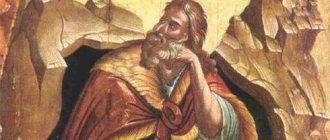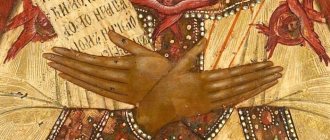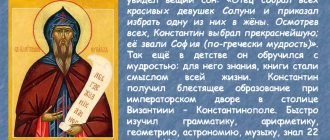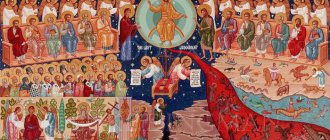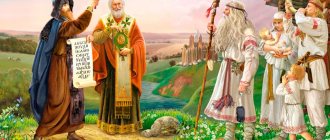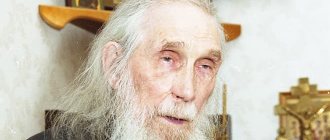Biography
Cyril and Methodius became famous throughout the world as champions of the Christian faith and authors of the Slavic alphabet. The biography of the couple is extensive; there is even a separate biography dedicated to Kirill, created immediately after the man’s death. However, today you can get acquainted with a brief history of the destinies of these preachers and founders of the alphabet in various manuals for children. The brothers have their own icon, where they are depicted together. People turn to her with prayers for good studies, luck for students, and increased intelligence.
Childhood and youth
Cyril and Methodius were born in the Greek city of Thessaloniki (present-day Thessaloniki) in the family of a military leader named Leo, whom the authors of the biography of the couple of saints characterize as “of good birth and rich.” The future monks grew up in the company of five other brothers.
Cyril and Methodius meet with the Slavic people
Before tonsure, the men bore the names Mikhail and Konstantin, and the first was older - he was born in 815, and Konstantin in 827. Controversy still rages among historians about the ethnicity of the family. Some attribute him to the Slavs, because these people were fluent in the Slavic language. Others attribute Bulgarian and, of course, Greek roots.
The boys received an excellent education, and when they matured, their paths diverged. Methodius entered military service under the patronage of a faithful family friend and even rose to the rank of governor of a Byzantine province. During the “Slavic reign” he established himself as a wise and fair ruler.
ABC of Cyril and Methodius
From early childhood, Kirill was fond of reading books, amazed those around him with his excellent memory and abilities in science, and was known as a polyglot - in his linguistic arsenal, in addition to Greek and Slavic, there were Hebrew and Aramaic. At the age of 20, a young man, a graduate of Magnavra University, was already teaching the basics of philosophy at the court school at Constantinople.
Christian service
Kirill flatly refused a secular career, although such an opportunity was provided. Marriage to the goddaughter of an official of the royal chancellery in Byzantium opened up dizzying prospects - leadership of the region in Macedonia, and then the position of commander-in-chief of the army. However, the young theologian (Konstantin was only 15 years old) chose to take the church path.
Saints Cyril and Methodius. Miniature from the Radziwill Chronicle, 15th century
When he was already teaching at the university, the man even managed to win a theological debate over the leader of the iconoclasts, the former Patriarch John the Grammar, also known as Ammius. However, this story is considered simply a beautiful legend.
The main task for the Byzantine government at that time was considered to be the strengthening and promotion of Orthodoxy. Missionaries traveled along with the diplomats who traveled to cities and villages where they negotiated with religious enemies. This is what Konstantin became at the age of 24, setting off on his first important task from the state - to instruct Muslims on the true path.
Icon of Cyril and Methodius
At the end of the 50s of the 9th century, the brothers, tired of the bustle of the world, retired to a monastery, where 37-year-old Methodius took monastic vows. However, Cyril was not allowed to rest for a long time: already in 860, the man was called to the throne of the emperor and instructed to join the ranks of the Khazar mission.
The fact is that the Khazar Kagan announced an interreligious dispute, where Christians were asked to prove the truth of their faith to Jews and Muslims. The Khazars were already ready to go over to the side of Orthodoxy, but they set a condition - only if the Byzantine polemicists won the disputes.
Kirill took his brother with him and brilliantly completed the task assigned to him, but still the mission was a complete failure. The Khazar state did not become Christian, although the Kagan allowed people to be baptized. On this trip, a serious historical event happened for believers. Along the way, the Byzantines looked into Crimea, where, in the vicinity of Chersonesos, Cyril found the relics of Clement, the fourth holy Pope, which were then transferred to Rome.
The brothers are involved in another important mission. One day, the ruler of the Moravian lands (Slavic state) Rostislav asked for help from Constantinople - they needed teacher-theologians to tell the people about the true faith in an accessible language. Thus, the prince was going to escape the influence of the German bishops. This trip became significant - the Slavic alphabet appeared.
Cyril and Methodius with their students
In Moravia, the brothers worked tirelessly: they translated Greek books, taught the Slavs the basics of reading and writing, and at the same time taught them how to conduct divine services. The “business trip” took three years. The results of the labors played a big role in preparing for the baptism of Bulgaria.
In 867, the brothers had to go to Rome to answer for “blasphemy.” The Western Church called Cyril and Methodius heretics, accusing them of reading sermons in the Slavic language, while they can only talk about the Most High in Greek, Latin and Hebrew.
Temple of Cyril and Methodius in Saratov
On the way to the Italian capital, they stopped in the Principality of Blaten, where they taught the people the book trade. Those who arrived in Rome with the relics of Clement were so happy that the new Pope Adrian II allowed services to be held in Slavonic and even allowed the translated books to be distributed in churches. During this meeting, Methodius received the episcopal rank.
Unlike his brother, Kirill only became a monk on the verge of death - it was necessary. After the death of the preacher, Methodius, surrounded by disciples, returned to Moravia, where he had to fight the German clergy. The deceased Rostislav was replaced by his nephew Svyatopolk, who supported the policy of the Germans, who did not allow the Byzantine priest to work in peace. Any attempts to spread the Slavic language as a church language were suppressed.
Cyril and Methodius
Methodius even spent three years in prison at the monastery. Pope John VIII helped to free him, who imposed a ban on liturgies while Methodius was in prison. However, in order not to escalate the situation, John also prohibited worship in the Slavic language. Only sermons were not punishable by law.
But the native of Thessaloniki, at his own peril and risk, continued to secretly conduct services in Slavic. At the same time, the archbishop baptized the Czech prince, for which he later appeared in court in Rome. However, luck favored Methodius - he not only escaped punishment, but also received a papal bull and the opportunity to again conduct services in the Slavic language. Shortly before his death he managed to translate the Old Testament.
Orthodox wedge
Author: Bishop Nikolai of BalashikhaHoly teachers, we pray to you with all earnestness: the peoples whom you have enriched with the treasure of the gospel, establish on the rock the confession of Christ... (St. Philaret of Moscow)
The purpose of our brief note on the iconography of Saints Methodius and Cyril, Equal-to-the-Apostles, is not so much to give an overview of the ancient surviving monuments (unfortunately, there are few of them), but to draw attention to the relevance of the topic: the annual holding of the Days of Slavic Literature and Culture caused the appearance of numerous and varied images of Thessalonica brothers. This includes traditional icon painting techniques, sculpture, and various graphic images. Obviously, the time is coming to work out the canons that artists who write, sculpt or draw Slavic enlighteners should adhere to.
Russia, XIX century Storage location: State Hermitage Museum, St. Petersburg
But before we begin the story about the images of the holy brothers, let us pay attention to what the Church considered important in their lives and works. It is well known that their veneration began soon after their repose. The early texts of the lives of Cyril and Methodius, approaching the synaxarion in style, are not so much statements of biographical data as evidence of the holiness of the brothers, whose task is to help establish their veneration. Contemporaries did not doubt the sanctity of Cyril's life; Already in the materials collected by his brother after his death, there is undoubted evidence of his holiness, in particular, that the Slavic alphabet was received by him as a revelation of God. The universal recognition of the saint was confirmed by the writing of the icon placed over his tomb [12].
The Life of Methodius, compiled in the decades closest to his death, contains the first text that has a liturgical sound - this is the final address, reminiscent of a troparion:
“But you, holy and honorable head, looking down upon us with your prayers from above, who have loved you, deliver your disciples from every misfortune, spreading the teaching and driving away heresies, so that having lived here worthy of our title, we will stand with you, your flock, at the right hand of Christ Our God, eternal life is received from Him, for to Him be glory and honor forever and ever” [12].
The oldest surviving sources contain references to “our venerable father Constantine the Philosopher, named in monkhood by the name of Cyril” (quite often) and Methodius, Bishop of Moravia (less often). These are the month books of the Ostromir and Assemanian Gospels, the month books of the Apostle from the Ohrid Monastery and others.
The first liturgical texts were compiled by the disciples of the Equal-to-the-Apostles brothers back in Moravia. The Praise and Service to Saint Cyril celebrates his virtuous life, zeal for holy icons, and missionary work. The saint's role in the enlightenment of the Slavic world is noted, but only along with his other educational exploits; he is compared with the Apostle Paul, and is not an educator of any one people. His merits in the creation of the Slavic alphabet are noted, but mainly he is praised for his writings (theological conversations).
The service, compiled shortly after Methodius’s repose, calls him “the great shepherd of the Slavs.” After the expulsion of the disciples Cyril and Methodius from Moravia, already in Bulgaria, they glorified the holy brothers primarily as educators of the Slavs. The liturgical texts of this time emphasize that Slavic writing is sacred, revealed to Cyril by God Himself. This aspect of the activity of the holy brothers is especially clearly emphasized during the reign of the Bulgarian kings Boris and Simeon.
Soon after the Baptism of Rus', the veneration of the Thessalonica brothers begins here; This is already evidenced by our first chronicle - “The Tale of Bygone Years.” It is interesting that in the narration of the Russian chronicler, the role of Methodius in the creation of the alphabet is greater than that of Cyril. And in Bulgaria in the 10th century, the veneration of the brothers equal to the apostles steadily increased in both spiritual and cultural life; the holy brothers became for the Bulgarian Church its spiritual forerunners.
At the beginning of the 11th century, from the time of the Byzantine Emperor Vasily II of the Bulgarian Slayers, due to the loss of autocephaly by the Bulgarian Church, the veneration of the Equal-to-the-Apostles brothers took on a different character. The Ohrid Archdiocese saw its task as preserving the Slavic spiritual tradition and the heritage of Equal-to-the-Apostles Clement of Ohrid, Methodius and Cyril. Apparently, it was then that they began to realize the need to preserve the appearance of the saints.
Ohrid's Hagia Sophia Cathedral was rebuilt and re-painted in the mid-11th century; Although almost half of the frescoes have been lost, even what has survived represents the most complete example of the embodiment of the theological program of painting in Byzantine churches of this time that has come down to us. Archbishop Leo of Ohrid, former hartophylax of the Patriarchate of Constantinople, drew up a program for painting the temple, and it was thanks to him that images of Slavic hierarchs - Equal-to-the-Apostles Clement of Ohrid and Cyril the Philosopher - appeared in the lower tiers of the painting of the altar and altar [8].
It is believed that the fresco is from the 11th century. in the Ohrid Church of St. Sophia is one of the earliest known images of Equal-to-the-Apostles Cyril. Unfortunately, its preservation is poor.
There is a mention that outside the Slavic world, in the Roman Basilica of St. Clement of the 9th century, there was an image of Equal-to-the-Apostles Cyril. These images date back to the 11th century. Their appearance in the Church of St. Clement is associated with the discovery by the Equal-to-the-Apostles brothers in Chersonesos of the venerable relics of the Holy Martyr Clement, Pope of Rome, during their missionary journey to Khazaria. On the walls of the temple of St. Clement, not only the transfer of his relics by the holy Thessalonica brothers is depicted, but also their trial. This last scene depicts the holy brothers kneeling before the Savior, and two angels, the Apostle Andrew and the Hieromartyr Clement, testifying in defense of the Slavic enlighteners.
In connection with the last topic, it seems appropriate to pay attention to a monument of Czech literature of the 10th century, known under the code name “Christian’s Legend”. It is a story about the first Czech saints - Cyril and Methodius, Vyacheslav and Lyudmila. This narrative began with a story about the activities of Cyril and Methodius, who converted the population of Great Moravia (St. Cyril) and the Czech Republic (St. Methodius) to Christianity, and it was noted that Cyril was a Greek by birth, who knew Greek and Latin writing well. An important place in this story is occupied by the topic related to the creation of Slavic writing. It talks about Cyril’s creation of the Slavic alphabet, the translation from Latin and Greek into Slavic of the Old and New Testaments and “many other” texts, the performance of services in the Slavic language and the conflict that arose in this connection between Cyril and the Latin clergy. The story ends with the words that Cyril managed to convince the Pope that he was right, proving that only in this way could he introduce such wild people and “who do not know the ways of God” to Christianity. The story, in which the true events from the life of Cyril are conveyed in a greatly altered form, shows what the attitude of the Prague bishop’s circle towards Slavic writing was in the 90s of the 10th century. The story “The Legend of Christian,” borrowed from the Extensive Life of Cyril, indicates that in the Czech Republic at the end of the 10th century there was worship in the Slavic language: “It is performed by many in the Slavic lands, and most of all in Bulgaria” [14].
In the famous Vatican minology, made for Emperor Basil II the Bulgarian Slayer, among four hundred wonderful miniatures illustrating the lives of saints and messages about memorable events in church history, there is also an image of Equal-to-the-Apostles Cyril and Methodius discovering the relics of the Hieromartyr Clement in the Crimea. The miniature was created no later than the beginning of the 11th century [9].
But let's return to the image of St. Cyril in Sophia of Ohrid. There is a whole gallery of saints presented there: the Patriarchs of Constantinople and Antioch, the Popes of Rome, the bishops of Asia Minor and other saints of the Universal Church; in the alatar part two saints are depicted, especially revered in the Ohrid Autocephalous Church - Cyril and Clement. Kirill is depicted full-length, with the inscription didaskaloV, i.e. teacher, - this name in the Orthodox Church was adopted specifically by St. Cyril, the creator of Slavic writing [4].
The Ohrid Archbishop of the late 11th - early 12th centuries, Theophylact, in the life of Clement of Ohrid, writes that this saint sought to imitate his mentor the Slavic Apostle Methodius in virtue, “just as one takes a picture of a great painter as a model.” By that time - by the 80s of the 9th century, when the Serbs became part of the Slavic Pannonian bishopric, headed by Bishop Methodius - the earthly life of another of Thessaloniki's brothers, Saint Cyril, had already ended.
One episode from the life of Equal-to-the-Apostles Cyril seems interesting, which had important consequences for icon painting in the Balkans, and then in Rus' - as a result of which inscriptions on icons began to be made in the Slavic language.
Constantine the Philosopher, the future Slavic educator Cyril, in a dispute with the iconoclast John, the former Patriarch of Constantinople, about why in Byzantium an image without an inscription is not revered, but a cross that does not have any inscription is revered, answered: “Every cross has the appearance of Christ’s cross, but not all icons have the same appearance.” Guided by this, Saint Sava of Serbia began to inscribe images of saints, starting with the paintings of Studenica (1208-1209), in the Slavic language. The Byzantines believed that every pictorial work only represents “the face and image of the one for whom it was written,” as testified by the anonymous writer, the author of the Slavic life of Cyril, which was written approximately after 869 [8].
There is an assumption that in Hagia Sophia of Ohrid, next to the image of the Slavic apostle Cyril and Clement of Ohrid, another Slavic apostle, Methodius, was presented, whose face was covered by a later layer of frescoes [7].
Another remarkable image of Equal-to-the-Apostles Cyril has been preserved in a small church near the capital of Bulgaria; it dates back to the 14th century. This period - from the beginning of the reign of Ivan Alexander (1331) to the conquest of the Tarnovo kingdom by the Ottoman Turks (1393) - is considered the “second golden age” of Bulgarian culture. The skill of provincial craftsmen of this period goes back to the best examples of the “Palaeologian Renaissance”. The paintings of the church in the village of Berende, located near the town of Godech (Sofia district), date back to this time; In these paintings, of particular interest to us is the image of revered saints, among which is the well-preserved Equal-to-the-Apostles Cyril.
The saint is depicted in polystaurium, in his hands he holds a scroll with the text: “Bless those who bless Thee and sanctify those who trust in Thee.” The image is inscribed with “St. Cyril the Philosopher.” It is believed that the Slavic enlightener Constantine-Kirill was awarded the title “Philosopher” most likely due to the fact that he was a philosophy teacher at the Magnaur School in Constantinople. In the preface to his lengthy life he is called “Constantine the Philosopher.” Already in early liturgical literature, in connection with his canonization with the name (in the schema) Cyril, he is called Cyril the Philosopher, for example, in the monthly book of the Assemanian Gospel of the 11th century, in the Menaion April of the 11th-12th centuries, in the Triodion of Grigorovich of the 12th-13th centuries, in the Synodikon “Boriloviya” of the 13th century [4].
In Rus', the veneration of the holy Slavic enlighteners was known already in the 11th century; The oldest services to them that have survived to our time date back to the 13th century. Few ancient images of saints have survived. In the Cyril Monastery in Kiev, frescoes around 1170, perhaps under the influence of Macedonian artists, depicted a number of saints who were especially revered in Macedonia and Thessaloniki: Saints Cyril, Methodius, Clement of Ohrid, John the Great, Joseph of Thessaloniki [8].
A cycle of miniatures depicting the saints Equal-to-the-Apostles Methodius and Cyril is contained in the Radziwill Chronicle, created at the beginning of the 15th century and containing the initial history of Ancient Rus' from its origins to 1206.
The original Radziwill Chronicle (named after the last owner), which ended up in the Koenigsberg Library in the mid-17th century, returned to Russia as a trophy of the Seven Years' War in 1761. Since 1818, the manuscript has been kept in the Library of the Academy of Sciences (BAN) in St. Petersburg . Among the 613 miniatures of this chronicle, there was also a place for the depiction of Slavic enlighteners [10].
The entire text of the Radzivilov Chronicle is Russian, and not translated from Greek; its initial part is “The Tale of Bygone Years”. The text of the chronicle, and after it the content of the miniatures, cover mainly the political history of Rus'. Hence the predominance of images of battles, military campaigns, princely negotiations, embassies, etc. However, there is present here and with a certain consistency, declarative clarity, another, as if parallel, aspect of history is revealed - the Christian one. Moreover, Rus', in accordance with the concept of the compilers, from the first pages of the narrative, appears as an integral part of the general Christian world, initially associated with the apostolic sermon addressed to it and the prophecy about it [11].
Following the miniatures, in which the “Sermon on Law and Grace” of the Kyiv Metropolitan of the mid-11th century Hilarion (speaking of the original involvement of Rus' in world Christianity) seems to receive a visible embodiment, a cycle of miniatures begins (No. 30-33), dedicated to the missionary activities of the holy Equal-to-the-Apostles Slovenian teachers, Constantine-Cyril and Methodius. This cycle is programmatic in nature [11].
In accordance with the text of the “Tale of Bygone Years,” the presentation of the activities of the holy brother-enlighteners of the Slavs follows as an inserted episode after the enumeration of the peoples conquered by the Ugrians under 898. The mention of the Moravians in this series gives the author of the chronicle the reason for the following entry: “Now the book of the Moravians was first translated, “It’s also called the Slovenian letter, it’s also in Rus' and among the Danube Bulgarians.” This is followed by news of the embassy of baptized Slavic princes to Emperor Michael III (842-867), returning the reader of the chronicle to the history of the creation of the Slavic charter [11].
The cycle of miniatures opens with a scene of the council of the Byzantine emperor with philosophers in Constantinople (left) and a scene of a conversation between the imperial envoy and the father of the holy brothers Leo in Thessaloniki (right), combined into one miniature (No. 30). Below on the same sheet of manuscript is presented, also double, the scene of the creation of “alphabet Slovenian letters” and at the same time the translation into Slavic of the Gospel, the Apostle, the Psalter and the Octoechos (No. 31) - and “the transposition of the Apostle and the Gospel” and, the chronicler adds, “rad The Slavs were like hearing the greatness of God with their tongue.” Then, the chronicler continues, the brothers “translated the Psalter, Octoechos and other books.”
Visually, the act of creation is miraculously instantaneous. In the process of working on the design of the manuscript, the miniature underwent serious alterations; traces of them are clearly visible. As a result, the illustrators chose the most traditional option in the form of the usual “author’s” portraits. And although the very text of the invented “alphabet” is presented extremely schematically, the sublime nature of the brothers’ work is obvious. On the reverse of the same sheet is a miniature (No. 32) depicting the installation of Saint Methodius by Pope Adrian II in 869 as Bishop of Pannonia. This scene is a kind of culmination of the cycle. Its triumphal character (also within the framework of the iconographic canon) makes obvious the great merits of the enlightener-hierarch who inherited the apostolic see [11].
This series is completed by a miniature (No. 33), which is usually interpreted as a scene of the ongoing educational activities of Saint Methodius - his translation of books from Greek into Slavic and their correspondence by two cursive writers. This interpretation actually corresponds to the text of The Tale of Bygone Years, recorded on fol. 13 vol. Radzivilov Chronicle. However, the nature of the paired scenes that make up the miniature allows us to raise a number of questions. First of all, because all three characters have halos, and this is unexpected: in the previous miniature only Methodius himself and Pope Adrian II are equipped with halos. It is possible that what we see on the left is the actual copying of books by order of Saint Methodius. On the right is a “portrait” of St. Cyril in the form of a monk who took monastic vows shortly before his death. At the same time, it is acceptable to believe that Cyril is also presented on the right in the previous scene, but as a copyist [11].
In other words, miniature No. 33, as it were, summarizes the activities of the brothers, giving the image - with all its innocence, if not primitiveness, an equally triumphant character. The activity of the brothers here is likened, with quite clear iconographic parallels, to the feat of the holy fathers - the creators of the Liturgy [11].
The text of “The Tale of Bygone Years” depicts the activities of Saints Cyril and Methodius in general terms, with large gaps in their biography. In particular, there is no episode, important for the Western and Central Byzantine world, of the visit of the Khazars, the discovery of the relics of St. Clement of the Pope, despite his widespread veneration in such centers of Rus' in the 11th-12th centuries as Kyiv and Novgorod the Great.
For the author of “The Tale of Bygone Years” and the illustrators, the overall result of the brothers’ activities and the involvement of Rus' in it are more important. The miniature in question is preceded by a text about the enlightener of the Slavs, Apostle Andronicus, and the preaching of the “Moravians” by the Apostle Paul: “That is why the teacher of the Slavs is the Apostle Paul, and we, Rus', are from the same Slavs; Therefore, for us, Rus', Paul is a teacher, since he taught the Slavic people and appointed Andronicus as an apostle and governor for the Slavs. But the Slavic people and the Russians are one; after all, they were called Russia from the Varangians, and before there were Slavs; although they were called polyans, their speech was Slavic. They were called Polyans because they sat in a field, and the language was common - Slavic.” The quoted text (fol. 13 vol. - 14) is concluded with miniature No. 33 [11].
One of the miniatures is dedicated to the construction of the St. Sophia Temple and the Golden Gate with the gate church. The following miniature (fol. 88, No. 198) to the words: “This Yaroslav, like a river, loved books, and having written many and placed them in St. Sophia and other churches, he placed them in cities and places, and appointed priests and gave them from his name, a lesson, commanding them to teach people...” - presents the scriptorium at the St. Sophia Cathedral. The miniature almost exactly repeats the scenes of the creation of the Slavic “alphabet” and the translation activities of Saints Cyril and Methodius, which were mentioned above. It seems to complete the initial stage of the enlightenment of Rus', both visually and in meaning [11].
It is appropriate here to quote the words of another chronicler (from the older version of the Novgorod Chronicle): “A wise man, without a book, is like a stronghold standing without supports; if there is wind, it will fall,” the Novgorod chronicler included these words of St. Ephraim the Syrian in his chronicle It is no coincidence: in the Orthodox consciousness of Ancient Rus', wisdom was inextricably linked with the book. It was as the founders of Slavic literature that our ancestors revered the Solunsky brothers.
By the time the iconographic originals were created, the iconography of Saints Methodius and Cyril almost lost connection with their early images, which is clearly seen from the text below: “May 11th - Saints Equal-to-the-Apostles Methodius and Constantine, monastically Cyril, Slovenian teachers: like the Bulgarian Slavs. St. Constantine, in the schema Cyril - middle-aged, i.e. 42, with a more than average-sized, full beard and forked at the end, streaked with gray; you can write him as a bishop in phelonion and omophorion; and as a schema-monk in a schema, in a mantle with tablets; in the hands of a charter with the inscription of his sayings: “God created man, between heaven and earth, between angels and beasts with reason, for he separated him from the beasts with reason, and with anger and lust separated him from the angels, and gave him free will, so that whoever wants, does, and whatever he approaches, he will find himself: or he will turn out to be an angel, working for God, as his enlightened mind will do; or the companion becomes a foolish beast, working with carnal lusts without self-restraint.”
You can write it with the book of the Gospel. He died in 869.
Saint Methodius is the elder brother of Saint Cyril: an old man, gray-haired, with a large but narrow beard; hair is not long, in phelonion and omophorion; in his hands is a book with the letters: A, B, C, - since he invented the alphabet and literacy for the Slavic language. You can also write him a charter, based on his life: “I ransacked that entire country, strengthened and convinced all the people, and drove out the Jews.” Or: “Like an elegant fighter, with prophetic words and apostolic words, like a warrior with both hands, shooting at the Jews, and at the heretics, and at them.” Died in 885."
Turning to the images of the Slavic enlighteners, when creating a new iconography, one should undoubtedly take into account not only the general recommendations of the iconographic originals, but also the inextricable spiritual unity of the Equal-to-the-Apostles brothers with universal Orthodoxy, which the authors of their early images tried to show - both in the painting of churches and in books miniature.
In the handwritten Menaion of the late 16th century from the collection of the Sofia Library (RNB) there is a remarkable note made by the scribe: “The servant of God Timothy wrote this book - my hand, our letter.” At all times, Slavic writing was, is and will be ours, that is, spiritually uniting the people of the Slavic world - and not only the Slavic, the entire Orthodox world - culture, history and, of course, faith. And at the origins of our writing we see the Equal-to-the-Apostles brothers of Thessaloniki, and, without having a portrait image of them, we clearly imagine their spiritual appearance.
Sources and literature: Angelov D. Kiril and Methodius and Byzantine literature and politics. - Hilyada and hundred godini Slavic pismenost. Sofia. 1963. Antonova V.I., Mneva N.E. Catalog of Old Russian painting of the 11th - early 18th centuries. (State Tretyakov Gallery). T.1-2. M., 1963. Artsikhovsky A.V. Old Russian miniatures as a historical source. Tomsk-M., 2004. Bakalova E. Paint murals on the tsarkvata near the village of Berendey. Sofia, 1976. Vasiliev As. Image Cyril and Methodius into something alien and find fine art. - Hilyada and hundred godini Slavic pismenost. Sofia. 1963. Granstrem E.E. Why was Metropolitan Kliment Smolyatich called “philosopher?” - TODRL, vol. 25. Grozdanov Ts. Portrait of Kliment Ohridski in medieval times. — Slovenska pismenost. Ohrid, 1966. Djuric V. Byzantine frescoes. Medieval Serbia, Dalmatia, Slavic Macedonia. M., 2000. Lazarev V.N. History of Byzantine painting. T.1. M., 1986. Podobedova O.I. Miniatures of Russian historical manuscripts. On the history of Russian facial chronicling. M., 1965. Popov G.V. The theme of Slavic enlightenment in miniatures of the Radzivilov Chronicle. — Old Russian art. Byzantium, Rus', Western Europe: art and culture. St. Petersburg, 2002. Takhiaos A-E.N. Holy brothers Cyril and Methodius, educators of the Slavs. Sergiev Posad, 2005. Florya B.N. Christianity in the Old Polish and Ancient Bohemian states in the second half of the 10th - first half of the 11th century. — Christianity in the countries of Eastern, South-Eastern and Central Europe on the threshold of the second millennium. M., 2002. Florya B.N., Turilov A.A., Ivanov S.A. The fate of the Cyril and Methodius tradition after Cyril and Methodius. St. Petersburg, 2000. Harisijadis M. Miniatures and ornaments of Octoechos r.64 in the Gradsk Library near Zagreb. — Collection on the face of skill. Novi Sad, 1968, building 4. Cirkovic S. Serbia. Middle Ages. (Slavic-Byzantine arch). M., 1996.
Source: www.mepar.ru Photo: www.lib.pstgu.ru
The Life of Methodius and Cyril, Slovenian Teachers The holy Equal-to-the-Apostles first teachers and Slavic educators, the brothers Cyril and Methodius, came from a noble and pious family that lived in the Greek city of Thessaloniki. Saint Methodius was the eldest of seven brothers, Saint Constantine (Cyril was his monastic name) was the youngest
The Russian language must be pure! Author: Irina Filippova These days the memory of Saints Equal-to-the-Apostles Cyril and Methodius, Slavic enlighteners, is celebrated. — Why is it generally accepted that language shapes human culture? — What is slang, jargon? Is their appearance acceptable in literary speech? — Is the fundamental approach to teaching the Russian language changing in schools and universities? — How useful is knowledge of the Church Slavonic language for modern schoolchildren? Teachers of the Orthodox Classical Gymnasium “Sofia” answer our questions
Reproduction on the Internet is permitted only if there is an active link to the ORTHODOX WEDGE website. Reproduction of site materials in printed publications (books, press) is permitted only if the source and author of the publication are indicated.
Creation of the alphabet
The brothers from Thessaloniki went down in history as the creators of the Slavic alphabet. The time of the event is 862 or 863. The Life of Cyril and Methodius states that the idea was born back in 856, when the brothers, together with their disciples Angelarius, Naum and Clement, settled on Mount Lesser Olympus in the Polychron monastery. Here Methodius served as rector.
Cyrillic and Glagolitic
The authorship of the alphabet is attributed to Kirill, but which one exactly remains a mystery. Scientists are inclined towards the Glagolitic alphabet, this is indicated by the 38 characters that it contains. As for the Cyrillic alphabet, it was brought to life by Kliment Ohridski. However, even if this was the case, the student still used Kirill’s work - it was he who isolated the sounds of the language, which is the most important thing when creating writing.
The basis for the alphabet was the Greek cryptography; the letters are very similar, so the Glagolitic alphabet was confused with the eastern alphabets. But to designate specific Slavic sounds, they took Hebrew letters, for example, “sh”.
Which churches have an icon of the saint?
The icon of St. Cyril is kept in churches in countries such as the Czech Republic, Macedonia and Bulgaria. All of these iconographic images date back to the 19th century, with the oldest of them being painted in 1893. This icon is located in the Church of St. Basil the Great, which is located in Talitsa.
Also, the image of St. Cyril is presented on the southern aisle of the Church of the Apostles Peter and Paul in St. Petersburg. Some churches in Moscow also have icons of this saint.
The icon of St. Cyril was painted several times and on each of the icons he is represented differently. On earlier icons, Saint Cyril is depicted in the clothes of a monk with a scroll in his hands; according to some sources, this is the Holy Scripture, according to others, the alphabet. Earlier icons represent the image of St. Cyril differently - with his right hand he blesses the believers, and in his left he holds a scroll.
Death
Constantine-Cyril was struck down by a serious illness on a trip to Rome, and on February 14, 869 he died - this day is recognized in Catholicism as the day of remembrance of saints. The body was interred in the Roman Church of St. Clement. Cyril did not want his brother to return to the monastery in Moravia, and before his death he allegedly said:
“Here, brother, you and I were like two oxen in harness, plowing one furrow, and I fell by the forest, having finished my day. And although you love the mountain very much, you cannot leave your teaching for the sake of the mountain, for how else can you better achieve salvation?
Methodius outlived his wise relative by 16 years. Anticipating death, he ordered himself to be taken to church to read a sermon. The priest died on Palm Sunday, April 4, 885. Methodius' funeral service was held in three languages - Greek, Latin and, of course, Slavic.
Monument to Cyril and Methodius
Methodius was replaced in his post by the disciple Gorazd, and then all the undertakings of the holy brothers began to collapse. In Moravia, liturgical translations were gradually banned again, and followers and students were hunted - persecuted, sold into slavery, and even killed. Some adherents fled to neighboring countries. And yet the Slavic culture survived, the center of book learning moved to Bulgaria, and from there to Russia.
The holy chief apostolic teachers are revered in the West and East. In Russia, a holiday has been established in memory of the brothers’ feat - May 24 is celebrated as the Day of Slavic Literature and Culture.
Prayer to Saints Cyril and Methodius Equal to the Apostles
For the glorification of the enlightener of the Slovenian language, Saints Methodius and Cyril, Equal to the Apostles, having been enlightened by the light of your writings and teachings and being instructed in the faith of Christ, as children of our father, we now earnestly run and with contrition of heart we pray: even if we do not keep your covenants, for pleasing God we are careless and from the fraternal unanimity in the faith of those who have fallen away, both as in ancient times in your earthly life, do not turn away the sinners and unworthy people now, but, as you have great boldness towards the Lord, diligently pray to Him, that He may turn us to the path of salvation, that He may pacify the discord of those of the same faith, may he lead those who have fallen away to unanimity and unite us all with the spirit of love into the One Holy, Catholic and Apostolic Church! We know that the prayer of the righteous can do much through the mercy of the Lord. Do not forsake us, sad and unworthy, your children, for the sake of their sins your flock is divided by enmity and seduced by the temptations of the heterodox, they have diminished, while the sheep of words are torn apart, admired by destructive wolves. Grant us, through your prayers, the zeal of Orthodoxy, so that we may well preserve the traditions of our fathers, we will faithfully observe the canons of the Church, we will run away from all strange false teachings, and, thus succeeding in living a life pleasing to God, we will be worthy of heavenly life in Heaven, where together with you we will glorify the One God in the Trinity forever and ever. . Amen.
( 2 ratings, average: 5.00 out of 5)
